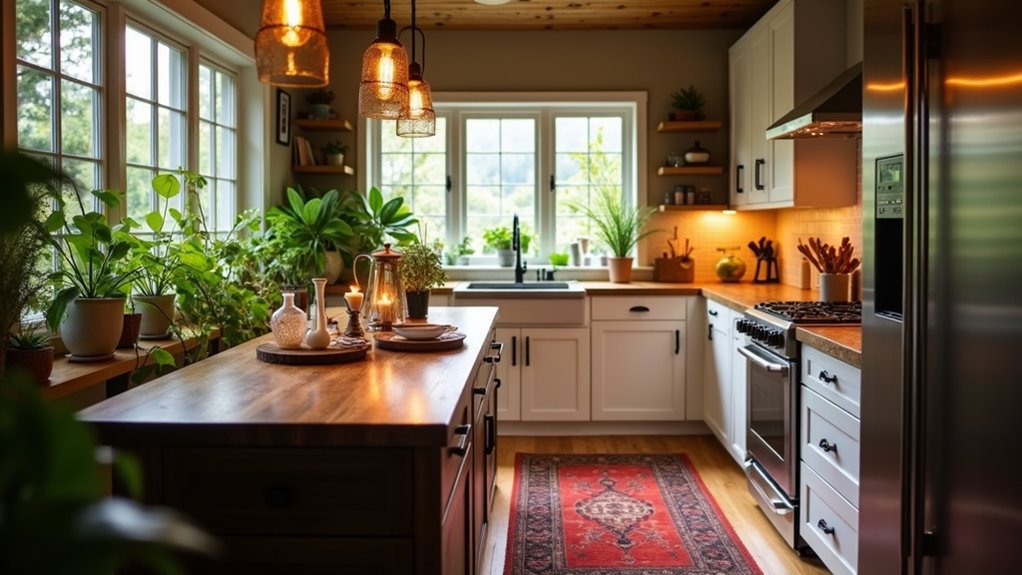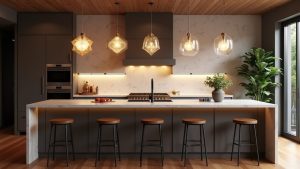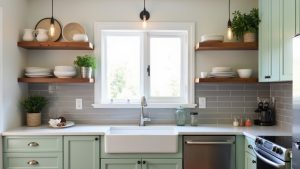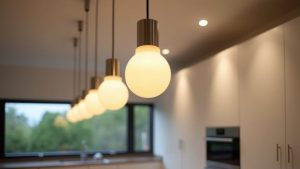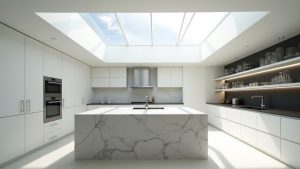Transforming a dim kitchen into a bright haven begins with assessing the current lighting layout. Investing in LED fixtures enhances energy efficiency while allowing flexibility. Selecting the right color temperature can elevate both ambiance and functionality. Incorporate task lighting for key work areas and utilize reflective surfaces to amplify illumination. Layering different light sources adds depth. Opting for bright, light-colored decor further maximizes natural light. Discovering additional strategies can turn that low light kitchen into an inviting space awaits.
Key Takeaways
- Use LED lighting solutions to maximize energy efficiency and enhance brightness, adjusting color temperatures to optimize task visibility and ambiance.
- Incorporate multiple layers of lighting, including ambient, task, and accent options, to create a well-lit, inviting kitchen space.
- Opt for light-colored cabinetry, walls, and countertops to reflect natural light and brighten the overall kitchen atmosphere.
- Strategically position mirrors and reflective surfaces to amplify light and create a sense of spaciousness in low light areas.
- Keep windows unobstructed and clean to maximize natural light penetration during the day for a brighter kitchen environment.
Assess Your Current Lighting Layout

An effective lighting scheme in a kitchen begins with a thorough assessment of the current lighting layout. Conducting a meticulous lighting analysis allows for the identification of key functional zones—cooking, prep, cleaning, and dining areas—which dictate specific lighting needs. Measuring kitchen dimensions aids in strategic fixture placement, ensuring that each space receives adequate illumination. Attention should be paid to the placement of architectural features like windows and cabinets that influence light distribution. Additionally, evaluating the availability of natural light throughout the day helps to determine how to best supplement it with artificial sources. By sketching a floor plan, homeowners can visualize potential locations for fixtures and electrical outlets, paving the way for a well-lit kitchen. Incorporating adjustable lights into your design can further enhance flexibility in illumination wherever needed. Modern kitchens often benefit from recessed LED lights installed to provide unobtrusive and energy-efficient lighting. To maximize workspace and eliminate darker corners, consider effective lighting as a key factor in your layout assessment.
Invest in LED Lighting Solutions

Investing in LED lighting solutions transforms low light kitchens into vibrant, functional spaces. Utilizing advanced LED technology, homeowners can achieve impressive energy savings, consuming up to 80% less power than traditional bulbs.
The design flexibility of LED strips and fixtures allows for easy installation in tight spaces, maximizing ambient lighting without clutter. With exceptional lighting longevity, LEDs boast an impressive lifespan of around 25,000 hours, reducing maintenance hassles and replacement costs.
Their brightness levels can be easily adjusted, enhancing visibility for cooking tasks while providing color versatility to suit various moods. This effective combination of efficiency and style not only elevates the kitchen’s aesthetics but also creates a more comfortable and inviting cooking environment. Moreover, many LED options offer dimmable features which enable tailored ambiance to suit different moods.
Choose the Right Color Temperature

After enhancing the kitchen’s brightness with LED lighting solutions, selecting the right color temperature becomes fundamental for creating the desired ambiance.
Color temperature, measured in Kelvin (K), can dramatically influence a kitchen’s atmosphere. Warm light (2700K-3000K) generates a cozy, inviting space, perfect for dining and relaxation, while cool white light (5000K-6500K) offers bright clarity that enhances task visibility for cooking.
Neutral white light (3500K-4000K) provides a balanced approach, maximizing functionality without sacrificing warmth. For optimal results, strategically combine these light temperatures—using cooler hues over work areas to improve focus and warmer tones in social spaces to foster comfort. Incorporating LED Integrated Floating Shelves with built-in lighting can further elevate the kitchen’s ambiance.
This careful selection establishes an ideal color ambiance tailored to the kitchen’s style and purpose.
Incorporate Task Lighting for Work Areas

Effective task lighting transforms kitchen work areas into well-lit zones that enhance both safety and efficiency. The strategic placement of task lights, particularly under-cabinet and recessed fixtures, illuminates essential kitchen work zones like countertops, sinks, and cooking areas, minimizing shadows and improving visibility.
Pendant lights above islands provide focused downward light, while adjustable track fixtures allow customization for various tasks. Cool white LED bulbs in the 4000K-5000K range ensure clarity for detail-oriented jobs. Incorporating modern glass pendant lights can enhance ambiance while providing focused task lighting for a stylish look.
Layered lighting beneath ambient sources helps combat glare and dark spots, creating a well-balanced environment. By prioritizing functional fixture choices, homeowners can create a beautifully illuminated kitchen, fostering an inviting atmosphere while improving workflow and safety during food preparation and cleaning.
Use Reflective Surfaces to Enhance Illumination

The addition of reflective surfaces in a kitchen can dramatically enhance the overall brightness of the space, building on the improvements achieved through strategic task lighting. Reflective finishes such as high-gloss countertops and mirrored backsplashes work wonders in amplifying both natural and artificial light, making the kitchen feel larger and more open.
Careful surface selection plays a vital role; by placing these materials behind sinks or above work areas, light amplification is maximized. These surfaces not only create an airy atmosphere but also stylishly connect the kitchen to outdoor views.
With minimal maintenance required, installing reflective features not only brightens the environment but contributes to energy savings, transforming the cooking space into a vibrant and engaging area.
Explore Smart Lighting Options

How can smart lighting transform a low light kitchen into a vibrant workspace?
With adjustable smart bulbs, homeowners can tailor brightness and color temperature to suit various kitchen tasks, from bright illumination for cooking to warm tones for dining.
Adjustable smart bulbs empower homeowners to customize brightness and color, enhancing both cooking and dining experiences in the kitchen.
Smart switches and apps allow for seamless lighting automation, enabling remote and scheduled control.
Incorporating smart light strips under cabinets provides additional brightness, enhancing work surfaces effortlessly through DIY installation.
Smart ceiling fixtures, equipped with motion sensors, ensure tailored lighting upon entry, while plug-in lamps and sconces help illuminate specific areas.
Add Under-Cabinet Lighting

While a kitchen can often be filled with vibrant colors and textures, adding under-cabinet lighting can dramatically enhance its functionality and aesthetic appeal.
Under cabinet fixtures, such as LED strips and puck lights, provide targeted illumination, minimizing shadows and boosting countertop visibility for food preparation.
The versatility of these lighting options—from energy-efficient LEDs to traditional xenon—allows for customization according to personal style and needs.
For convenience, lighting installation can include plug-in or battery-operated options, while hardwired fixtures offer a more permanent solution.
This thoughtful addition not only elevates the kitchen’s ambiance but also ensures safety by reducing electrical hazards, making it an essential component in any low-light space.
Optimize Natural Light With Lighter Decor

To maximize the influx of natural light in a low-light kitchen, selecting lighter decor becomes essential.
Light-colored cabinetry, walls, and countertops effectively reflect sunlight, creating an inviting brightness.
Ideal window positioning, such as south-facing or larger openings, enhances this effect, allowing ample daylight to flood the space.
Incorporating reflective materials like glass, polished metals, and glossy tiles amplifies light dispersion, preventing shadows and dark corners.
Open shelving and glass cabinet doors invite the sunlight to traverse the kitchen freely, while minimizing visual heaviness.
To maintain optimal brightness, it’s crucial to keep windows unobstructed and choose sheer treatments.
Together, these elements harmonize to create a cohesive, airy atmosphere, transforming the kitchen into a luminous haven.
Layer Your Lighting for Depth

Layering lighting in a kitchen can transform a dim space into an inviting and functional environment.
By employing layering techniques, one can achieve a beautiful interplay of light sources. Ambient lighting, such as recessed lights, establishes a warm foundation, while task lighting, like under-cabinet fixtures, focuses illumination on essential work areas.
Accent lighting, including wall sconces, highlights unique architectural details, creating interest and character.
Lighting placement is crucial; pendants over islands add both style and functionality, enhancing the overall aesthetic. Incorporating decorative pieces, like sculptural fixtures, introduces artistic flair.
Together, these layers create depth and dimension, ensuring a well-lit space that transitions seamlessly from practical cooking to cozy gatherings.
Consider Bright White Walls and Ceilings

In a low light kitchen, the choice of wall and ceiling colors plays a pivotal role in creating a well-illuminated space. Opting for bright white walls and ceilings enhances light reflection, making the kitchen appear more spacious and airy. This brilliant hue not only amplifies natural and artificial light but also complements decorative accents effortlessly.
Choosing bright white walls and ceilings in a low light kitchen boosts light reflection, creating a spacious and inviting atmosphere.
- Evokes a fresh, clean ambiance that uplifts the mood.
- Connects seamlessly with various color palettes and decor styles.
- Fosters an inviting atmosphere, reducing the presence of shadows.
Using glossy or semi-gloss white paint maximizes illumination further. Bright white surfaces can transform a dim kitchen, promoting a vibrant and welcoming cooking environment while requiring less artificial lighting.
Regular maintenance keeps that brightness pristine, ensuring lasting beauty.
